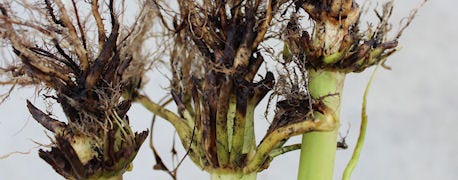
An unsettling trend is emerging in parts of northern Illinois.
More and more growers are seeing signs of severe corn rootworm injury in hybrids with Bt traits designed to protect against these pests. Bryan Johnston, owner of Cabery Fertilizer, invited University of Illinois entomologists Mike Gray and Joe Spencer to look at severe cases in late August.
Gray and Spencer took samples from a field planted with a hybrid that included Monsanto's Cry3Bb1 rootworm trait. However, Johnston indicates the severe injury may not be confined solely to Cry3Bb1.

PRUNED ROOTS: U of I's Mike Gray and Joe Spencer dug up multiple plants in Kankakee County to find severe root pruning. These roots contain the Cry3Bb1 protein. Photo courtesy of Mike Gray, University of Illinois.
"It's very frustrating for a lot of growers to be paying for the trait packages and still have to put on a granular insecticide to guarantee protection," Johnston adds.
Even more unsettling is the fact that these were first-year corn fields. Gray says this most assuredly means they're dealing with a CRW variant population, i.e. an evolved species that seeks out soybean fields to lay eggs for overwintering. This ensures the CRW larvae hatch into a fresh-planted corn field the following spring.
"I asked the grower, 'How long have you been rotating between corn and soybeans,'" Gray notes. "His answer – forever."
Johnston also notes these are not isolated instances of extreme rootworm pressure. In his 30-mile wide coverage area, he's seen numerous instances of CRW damage.
He says they've dealt with high CRW pressure in the past, but it just "exploded" this summer. Something is going on, he adds.
Extreme pressure
Luke Samuel, Monsanto's corn insect traits product development manager, says this situation is more likely a combination of several factors.
"What we're seeing today is it's more of a pressure issue," Samuel says.
He notes last year's drought caused many corn fields to burn up prematurely – an unappealing place for adult CRW beetles to lay eggs. Therefore, he says the CRW variant populations likely chose to lay eggs in soybean fields instead.
He adds that Monsanto hasn't seen an influx of performance inquires associated with Cry3Bb1 this year over last year. Still, he recommends planting a Genuity SmartStax hybrid for growers concerned about rootworm pressure. SmartStax adds another mode of action – Cry34/35Ab1 – for added protection.
~~~PAGE_BREAK_HERE~~~
Next year
Gray and Spencer took numerous samples from fields with significant root pruning and lodging in Kankakee and Livingston Counties. Spencer is conducting bioassays on the insects to determine if they are resistant to Cry3Bb1. Gray notes it will take some time to obtain the results. (Here's why.)
In the meantime, Gray recommends planting a pyramided hybrid with added Bt protection. Next year, Syngenta will launch their Agrisure Duracade hybrids, which combines their mCry3A protein with the new eCry3.1Ab protein.
For growers who stick with a single mode of action hybrid that has failed previously, Gray recommends they consider a soil-applied insecticide to boost protection. He encourages growers to keep in mind that use of a non-Bt hybrid with a soil insecticide remains an option as well. To date, Gray and Samuel do not recommend using a soil insecticide with a pyramided hybrid.
Johnston isn't so sure. Seeing how quickly the problem developed in his area, he says a soil-applied insecticide may be wise to add another mode of action to pyramided hybrids.
About the Author(s)
You May Also Like




